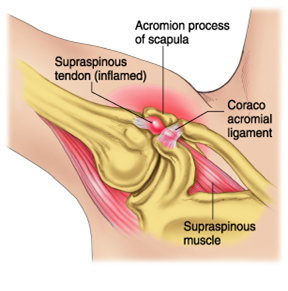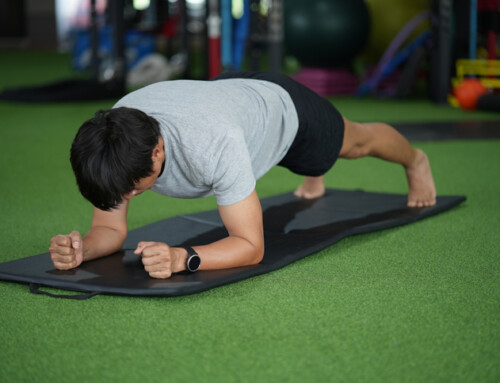By Jen Mirdita, SPT
What Is Subacromial Impingement Syndrome?
Subacromial Impingement Syndrome is caused by the compression of soft tissue structures between the acromion/acromioclavicular joint and the humeral head during active elevation of the arm above shoulder height. The structures commonly affected include the rotator cuff tendons, biceps, tendons, and the subacromial bursa, which acts as a lubricant to help these tendons glide easily. Normally, there is enough space between the acromion and the head of the humerus to allow tendons to glide during arm elevation. Any process which comprises this normal gliding function may
Other contributing factors:
- Increasing age
- Previous injury to shoulder joint or surrounding structures
- Osteoarthritis resulting in bone spurs
- Repetitive overhead activities such as weight lifting, throwing, and painting
- Anatomical abnormalities which may decrease the amount of space under the acromion
- Muscle imbalances which change the kinematics of the shoulder joint and scapula
- Tightness of the capsule which holds the shoulder joint together, typically posteriorly
- Postural imbalance
- Shoulder joint laxity
What are management options?
It is common that pain may be managed with injections of a corticosteroid and local anesthetic may be used for persistent impingement syndrome, however, the number of injections is typically limited to three due to the possible side effects of corticosteroids.
In more severe cases, a few surgical interventions are available, depending on the nature and location of the pathology. The goal of most surgeries are aimed at removing impinging structures, widening subacromial space and removing osteophytes on the under-surface of the acromioclavicular joint.
Conservative management techniques are strongly desired over surgical intervention, thus physical therapy should be considered as the first course of action.
How can PT help?
By taking a history and performing a physical assessment, your physical therapist can get a better understanding of the underlying issues causing pain and dysfunction. With this information, your plan of care will be established to suit your individual impairments and goals. Physical therapy treatments typically focus on education on posture and body mechanics, maintaining or improving range of movement, strengthening of shoulder muscles, stabilization exercises, and pain management. Manual techniques and physical modalities including soft tissue mobilization, joint mobilization, therapeutic taping techniques, electrotherapy, hot/cold therapy.
If you have questions or think we can help, give us a call at our Malta Clinic at (518) 289-5242 or our Queensbury Clinic at (518) 502-1154 to schedule your appointment!
References:
1. Impingement Syndrome – Medical Disability Guidelines. Mdguidelinescom. 2016. Available at: https://www.mdguidelines.com/impingement-syndrome. Accessed November 21, 2016.
2. Subacromial Impingement – Physiopedia, universal access to physiotherapy knowledge. Physio-pediacom. 2016. Available at: http://www.physio-pedia.com/Subacromial_Impingement. Accessed November 21, 2016.




